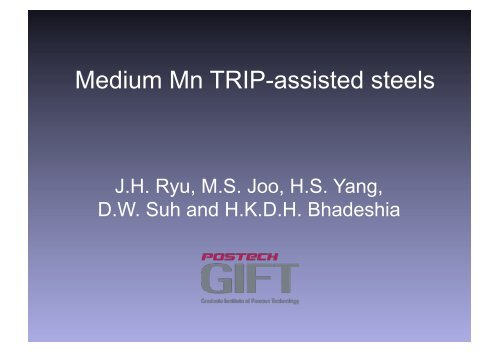Medium Mn TRIP-assisted steels
Medium Mn TRIP-assisted steels
Medium Mn TRIP-assisted steels
Create successful ePaper yourself
Turn your PDF publications into a flip-book with our unique Google optimized e-Paper software.
<strong>Medium</strong> <strong>Mn</strong> <strong>TRIP</strong>-<strong>assisted</strong> <strong>steels</strong><br />
J.H. Ryu, M.S. Joo, H.S. Yang,<br />
D.W. Suh and H.K.D.H. Bhadeshia
Content<br />
1. Research Background<br />
2. <strong>Medium</strong> <strong>Mn</strong> <strong>TRIP</strong>-<strong>assisted</strong> <strong>steels</strong><br />
- Effect of aluminum on mechanical performance<br />
3. C and <strong>Mn</strong> balance in Al-reduced <strong>Mn</strong> <strong>TRIP</strong>-<strong>assisted</strong> <strong>steels</strong><br />
- Integration of grain size effect on kinetics of martensite<br />
transformation<br />
4. Summary
Excellent mechanical balance<br />
• Typical phase fraction in conventional <strong>TRIP</strong> <strong>steels</strong><br />
: polygonal ferrite, 70~80%<br />
bainitic ferrite, 10~15%<br />
retained austenite, 10~15%<br />
Austenite<br />
Martensite
Microstructural modification<br />
bainitic ferrite<br />
polygonal ferrite<br />
<strong>TRIP</strong>-aided bainitic ferrite <strong>steels</strong><br />
AM <strong>TRIP</strong> <strong>steels</strong><br />
bainitic ferrite<br />
austenite<br />
austenite<br />
austenite<br />
Metastable austenitic steel (Fe-C-Ni-Cr-<strong>Mn</strong>)<br />
High <strong>Mn</strong> <strong>TRIP</strong> steel (>10wt%)<br />
P, Cu for ferrite strengthening<br />
Larger γ fraction with <strong>Mn</strong> (4~8wt%)
<strong>Medium</strong> manganese <strong>TRIP</strong> <strong>steels</strong><br />
• 0.1C-6<strong>Mn</strong> based alloy introduced by R.L Miller in 1972<br />
• Annealing of cold-rolled martensite<br />
• Micro-duplex structure : polygonal ferrite, 60~70%<br />
retained austenite, 30~40%<br />
R.L. Miller, Metall. Trans., 3 (1972) 905.<br />
∼1150MPa<br />
Fe-0.11C-5.7<strong>Mn</strong><br />
Annealed for 16h at 600 o C
Application of continuous annealing<br />
Recrystallization of ferrite<br />
Annealing temperature<br />
Reverse transformation of austenite<br />
Strategy and approach<br />
- suppression of extra-formation of austenite<br />
at higher temperature permitting recrystallization<br />
Aluminum addition
Fe-0.12C-5<strong>Mn</strong>-Al<br />
• Modified Fe-Al-<strong>Mn</strong>-C<br />
database<br />
*Under complete redistribution of<br />
C and <strong>Mn</strong> at 800 o C,<br />
M s ~ 151 o C<br />
α<br />
γ<br />
0Al<br />
α<br />
α<br />
γ<br />
γ<br />
1Al<br />
3Al
Alloys to investigate Al effect<br />
C <strong>Mn</strong> Si Al (wt.%)<br />
L-Al 0.12 4.6 0.55 1.1<br />
H-Al 0.12 5.8 0.47 3.1<br />
Temp.<br />
reheating<br />
hot rolling<br />
~4.5mm<br />
annealing for<br />
2min.<br />
A e1<br />
L-Al, 660, 720, 780 o C<br />
H-Al, 720, 780, 840 o C<br />
10 o C/s 10 o C/s<br />
cold rolling<br />
~1.0mm<br />
Time
Microstructure after hot-rolling<br />
L-Al alloy<br />
H-Al alloy<br />
α’<br />
α<br />
10μm
Microstructure<br />
(a) 660 o C<br />
after annealing<br />
(L-Al alloy)<br />
(b) 720 o C<br />
(c) 780 o C<br />
10μm
Microstructure<br />
(a) 720 o C<br />
after annealing<br />
A<br />
(H-Al alloy)<br />
B<br />
(b) 780 o C<br />
(c) 840 o C<br />
C
Retained austenite<br />
H-Al annealed at 780 o C<br />
α<br />
γ
Phase maps of annealed sheets<br />
1.1Al (720 o C) 3.1Al (780 o C)<br />
f γ =27.9% f γ =31.3%<br />
Fine-grained structure of<br />
austenite
Mechanical behaviors<br />
L-Al<br />
H-Al<br />
DR=1.8
Mechanical stability of austenite<br />
A<br />
B<br />
ΔT ~ 30 o C
C and <strong>Mn</strong> balance in Al-reduced <strong>steels</strong><br />
• High Al content in steel<br />
- interaction with mold flux during continuous casting<br />
- interaction with refractory<br />
• Reduced Al in alloy design<br />
- reduced C or <strong>Mn</strong> to maintain austenite fraction and stability<br />
at intercritical annealing<br />
(H-Al alloy)
Investigated alloys<br />
C <strong>Mn</strong> Si Al (wt. %<br />
)<br />
Alloy 1 0.11 4.5 0.45 2.2<br />
Alloy 2 0.075 5.1 0.49 2.1<br />
Alloy 3 0.055 5.6 0.49 2.1<br />
* H-Al, 0.12C - 5.8<strong>Mn</strong> - 0.47Si - 3.1Al
Microstructures of annealed alloys
Mechanical properties<br />
alloy 1<br />
alloy 3
Mechanical properties
Kinetics of martensite transformation<br />
• Influence of austenite composition<br />
on the martensite formation kinetics<br />
(M. Sherif et al., Materials Science and Technology, 2004)<br />
• Influence of grain size on decrease of<br />
M s temperature<br />
(H. S. Yang et al., Scripta Materialia, 2009)<br />
V : average volume of an austenite grain<br />
f : first detectable martensite fraction, 0.01<br />
m : aspect ration of marteniste plate, 0.05<br />
Influence of grain size on M s temperature decrease is converted into<br />
extra free energy required for the martensite transformation
Kinetics of martensite transformation<br />
alloy 1<br />
k 1 = 0.008 mol/J<br />
alloy 3<br />
- Since the grain size of austenite is similar in all alloys, the mechanical stability<br />
of austenite is primarily affected by chemical effect<br />
- Effect of carbon is more critical even though we can obtain similar fraction of<br />
austenite by altering C / <strong>Mn</strong> concentration
Summary<br />
• Low carbon, medium <strong>Mn</strong> <strong>TRIP</strong> steel with Al<br />
- potential candidate for advanced <strong>TRIP</strong> steel<br />
showing improved mechanical balance <br />
• C / <strong>Mn</strong> balance in Al-reduced <strong>Mn</strong> <strong>TRIP</strong> steel<br />
- similar microstructure withcomparable austenite fraction<br />
- C has more critical effect on mechanical stability of<br />
austenite and thus uniform elongation

















